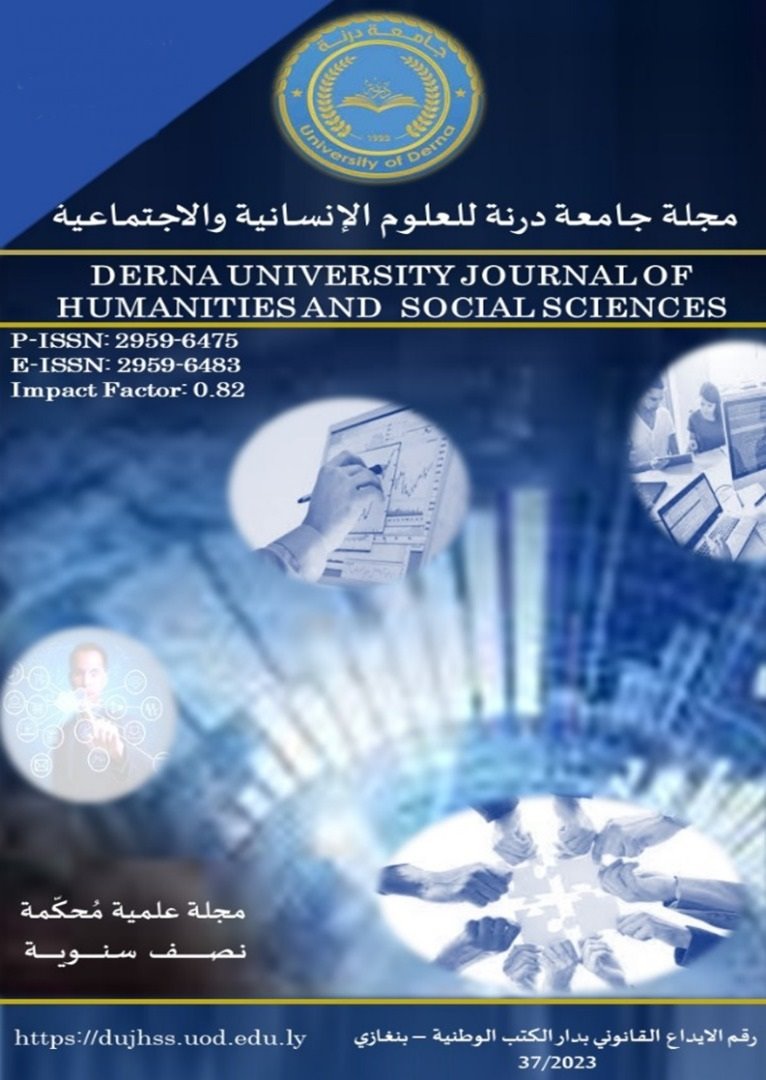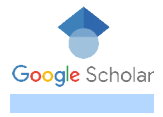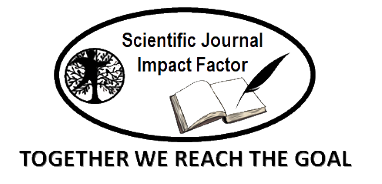Exploring the role and use of YouTube in learning the English language components for Libyan University students: Faculty of Art and Science Saloug as a case study, Benghazi University
Keywords:
YouTube, learning English language, the Department of Art and Science, Saloug, Benghazi UniversityAbstract
This research explores the role and use of YouTube in learning English language components for Libyan university students at the Department of Art and Science, Saloug, Benghazi University. The participants are 75 students chosen randomly. The data were collected using Likert-scale questionnaires ranging from agree, neutral to disagree. The findings revealed that YouTube is a valuable resource for Libyan English language learners due to its wide range of content, accessibility, and teaching styles. The participants reported that YouTube is beneficial for developing their learning of English language components. The researcher found that vocabulary improvement was the primary focus for the participants. Further studies are needed to address YouTube's limitations and provide guided practice and feedback.
References
Alimemaj, Z. (2010). YouTube, language learning, and teaching techniques. The Magazine of Global English-Speaking Higher Education, 2(3), 10-12.
Al Jawad, A. (2020). The impact of using YouTube videos to promote students’ performance in speaking skills: A case study of a school in Libya. Journal of English Language Teaching and Applied Linguistics, 2(3), 38-46. Retrieved from http://www.jeltal.org
Al Jawad, A. S. H., & Mansour, A. A. (2021). The significance of using YouTube as an academic tool to improve students’ listening skills in Libyan universities. International Journal of Linguistics Studies, 1(1), 58-70. https://doi.org/10.32996/ijls.2021.1.1.5
Almurashi W. (2016) The effective use of YouTube videos for teaching English language in classrooms as supplementary material at Taibah University in Alula. International Journal of English Language and Linguistics Research. 4(3).32-47.
Aprianto, A. (2020). To what extent does YouTube content-based language learning promote English proficiency? Journal of English Language Teaching and Literature, 3(2), 108-126. https://doi.org/10.47080/jeltl.v3i2.994
Alshraideh, D. S. (2021). EFL learners’ and teachers’ perception toward the use of online videos in EFL classes. Arab World English Journal, 12(1), 215-228. https://doi.org/10.24093/awej/vol12no1.15
Audina, I. P., Artini, L. P., Dewi, N. L. P. E. S., & Suwastini, N. K. A. (2022). YouTube videos for listening skills during Covid-19 pandemic: EFL students’ views. Jurnal Penelitian dan Pengembangan Sains dan Humaniora, 6(3), 38-46. https://doi.org/10.23887/jppsh.v6i3.55809
BBC Learning English. (2024, September 23). BBC Learning English [YouTube channel]. YouTube. https://www.youtube.com/user/bbclearningenglish
Berk, R. A. (2009). Multimedia teaching with video clips: TV, movies, YouTube, and mtvU in the college classroom. International Journal of Technology in Teaching and Learning, 5(1), 1-21.
Brook, J. (2011). The affordances of YouTube for language learning and teaching. Hawaii Pacific University TESOL Working Paper Series, 9(1-2), 37-56. Retrieved from https://www.hpu.edu/research-publications/tesol-working-papers/2011/9_1-2_Brook.pdf
Brown, H. D. (2001). Teaching by principles: An interactive approach to language pedagogy. New York, NY: Addison Wesley Longman, Inc.
Berk, R. A. (2009). Multimedia teaching with video clips: TV, movies, YouTube, and mtvU in the college classroom. International Journal of Technology in Teaching and Learning, 5(1), 1-21.
EF Education First. (2024, September 23). EF Education First [YouTube channel]. YouTube. Retrieved from https://www.youtube.com/c/EfEducationFirst
English Addict with Mr. Duncan. (2024, September 23). Speak English With Mr. Duncan [YouTube channel]. YouTube. Retrieved from https://www.youtube.com/user/duncaninchina
Feldman, D. C. (2007). Organizational embeddedness and occupational embeddedness across career stages. Journal of Vocational Behavior, 70(2), 336-351. https://doi.org/10.1016/j.jvb.2006.10.0021
Ghasemi, B., & Hashemi, M. (2011). Foreign language learning during childhood. Procedia - Social and Behavioral Sciences, 28, 872-876. https://doi.org/10.1016/j.sbspro.2011.11.160
Harlinda, N. (2019). Students’ perceptions in using YouTube as media for learning English as a foreign language. Undergraduate thesis, IAIN Palangka Raya. http://digilib.iain-palangkaraya.ac.id/2103/
Harman, K., & Koohang, A. (2005). Open source: A metaphor for e-learning. Informing Science: International Journal of an Emerging Transdiscipline, 8, 75-86. https://doi.org/10.28945/2867
Hung, D., & Nichani, M. (2001). Constructivism and e-learning: Balancing between the individual and social levels of cognition. Educational Technology, 41(2), 40-44. https://eric.ed.gov/?id=EJ625229
Jalaluddin, M. (2016). Using YouTube to enhance speaking skills in ESL classroom. International Journal of Emerging Technologies in Learning (iJET), 11(3), 123-129. https://doi.org/10.3991/ijet.v11i03.53661
Jalova, M. (2014). Contextual influences on English language teaching in Libya. Journal of English Language Teaching and Applied Linguistics, 2(3), 45-58.
Kabooha, R., & Elyas, T. (2015). The impact of using YouTube videos on learning vocabulary in Saudi EFL classrooms. English Language Teaching, 11(2), 72. https://doi.org/10.5539/elt.v11n2p72
Kadek, P. A., Suwastini, N. K. A., Adnyani, N. L. P. S., Dantes, G. R., & Jayantini, I. G. A. S. (2021). Integrating social media into English language learning: How and to what benefits according to recent studies. NOBEL: Journal of Literature and Language Teaching, 12(1), 91-111. https://doi.org/10.15642/NOBEL.2021.12.1.91-111
Kelsen, B. (2009). Teaching EFL to the iGeneration: A survey of using YouTube as supplementary material with college EFL students in Taiwan. CALL-EJ Online, 10(2), 1-18.
Kim, J., & Kim, H. (2021). The impact of digital learning tools on student engagement and performance. Journal of Educational Technology, 18(3), 45-60. https://doi.org/10.1234/jet.v18i3.5678
Meinawati, E., Purwaningrum, P. W., Alawiyah, S., & Setianingrum, H. W. (2022). The effectiveness of YouTube as an e-resource on students’ writing learning. Al-Ishlah: Jurnal Pendidikan, 14(4), 6907-6916. https://doi.org/10.35445/alishlah.v14i4.2790
Pew Research Center. (2021). Social media use in 2021. Pew Research Center. https://www.pewresearch.org/internet/2021/04/07/social-media-use-in-2021/
Purnamasari, A. (2018). What EFL learners say about YouTube use to improve pronunciation in a blended learning environment. JET Journal of English Teaching, 4(3), 205-215. https://doi.org/10.33541/jet.v4i3.1338
Rao, S. P. (2019). The importance of speaking skills in English classrooms. Alford Council of International English & Literature Journal, 2, 6-18.
Rashid, A., Khan, S., & Sheikh, F. R. (2022). Investigating EFL teachers’ perceptions of the use of YouTube in the development of Saudi EFL university students’ speaking skills. Journal of English Language, Literature and Education, 3(4), 54-73. https://doi.org/10.54692/jelle.2022.0304111
Riswandi, D. (2016). Use of YouTube-based videos to improve students’ speaking skill. Proceeding of the International Conference on Teacher Training and Education, 2(1), 131-139. https://doi.org/10.20961/ictte.v2i1.8150
Sakkira, G., Dollah, G., & Ahmad, J. (2020). Students’ perceptions toward using YouTube in EFL classrooms. Journal of Applied Science, Engineering, Technology, and Education, 2(1), 1-10. https://doi.org/10.1234/jasete.v2i1.1234
Sherman, J. (2003). Using authentic video in the language classroom. Cambridge: Cambridge University Press.
Statista. (2023). 2023 in numbers. Statista. https://www.statista.com/study/162268/2023-in-numbers/
Tahmina, T. (2023). Students’ perception of the use of YouTube in English language learning. JOLLT Journal of Languages and Language Teaching, 11(1), 151-159. https://doi.org/10.2338-0810.2023.11.1.151
TED. (2024, September 23). TED [YouTube channel]. YouTube. Retrieved from https://www.youtube.com/@TED
Wang, Y., Chen, N.-S., & Levy, M. (2021). Exploring the effectiveness of using YouTube as a tool for learning English. Journal of Educational Technology & Society, 24(1), 45-58. https://doi.org/10.12345/jets.2021.24.1.45
Watkins, J., & Wilkins, M. (2011). Using YouTube in the EFL classroom. Language Education in Asia, 2(2), 113-119. https://leia.org/LEiA/LEiA%20VOLUMES/Download/LEiA_V2_I1_2011/LEiA_V2I1A09_Watkins_Wilkins.pdf
Web Analytics Association. (2006). Google.com tops list of college students’ favorite websites– But only through purchase of YouTube.com. Web Analytics Journal, 5(3), 45-50.
Vygotsky, L. S. (1978). Mind in society: The development of higher psychological processes. Harvard University Press.
Zhou, Q., Lee, C. S., Sin, S.-C. J., Lin, S., Hu, H., & Fahmi Firdaus Bin Ismail, M. (2020). Understanding the use of YouTube as a learning resource: a social cognitive perspective. Aslib Journal of Information Management, 72(3), 339-359. https://doi.org/10.1108/AJIM-10-2019-0290



























